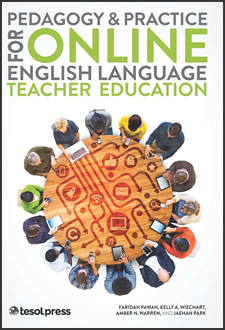|
 Chapter 1: Teaching Presence in Online Teaching Chapter 1: Teaching Presence in Online Teaching
by Faridah Pawan
From Pedagogy and Practice for Online English Language Teacher Education (Faridah Pawan, Kelly A. Wiechart, Amber N. Warren, and Jaehan Park)
[If we accept] successful teaching is a combination of intellectual commitment and embodied experience—that it is as much thought as it is action—then we need to advocate for the learning environment that allows both to play out.
—Lucia Volk, “Teach It Like You Mean It,” 2012, para 23
In the U.S. movie The Wizard of Oz, a teenager named Dorothy along with her dog, Toto, are carried by a tornado to the Land of Oz. The movie goes on to describe Dorothy’s quest to meet a well-known wizard to get his help to find her way home. She is accompanied by a group of three friends on her journey, namely the Scarecrow, the Tin Man, and the Lion. The Scarecrow wants the wizard to give him a brain so he can be intelligent; the Tin Man wants a heart so he can feel emotion; and the Lion wants courage so he can be brave. Although no one has ever seen the wizard, they are all convinced he has the power to help them. Part of their quest involves following a yellow brick road. The movie ends with Dorothy and her friends realizing that it is not the wizard himself but the knowledge of him being present that enables them to discover their own strengths and help themselves. This realization comes about when they find out that wizard is an ordinary man creatively using tools at his disposal to make things happen. In a way, the story of the Wizard of Oz represents the potential of presence to be a powerful guiding force to productive outcomes. However, there is careful planning and work behind the presence that makes it effective.
In this chapter, I discuss the theoretical conceptualization of teaching presence and provide examples of its implementation from an online graduate program for new and in-service teachers of English as a second language (ESL).
Presence Theory
Presence as a theoretical concept emerged from social presence and teacher immediacy research (Lowenthal & Parscal, 2008). Social presence is defined by Short, Williams, and Christie (1976) as the “saliency” or mutual noticeability of interlocutors, or communicators, and the consequences of that noticeability. The medium of communication is central to this conceptualization of saliency in that it determines the nature of the presence (Lowenthal & Parscal, 2008). For example in video materials, there is both visual and audio presence whereas in audio-only materials there is only audio presence. Immediacy is another component of social presence, which in its positive sense, Mehrabian and Epstein (1972) define as linguistic and nonlinguistic communication that develops a sense of affinity between communicators. It is the ability to effectively project approachability, likeability, and interest in sustaining engagement into the communication situation while being aware of these attributes in others.
Saliency and immediacy thus constitute social presence in that it depends on interlocutors’ engagement with others around them. In this regard, social presence is “a complex and nuanced aspect of teaching” not a “checklist of behaviors, dispositions, measures, and standards” (Rogers & Raider-Roth, 2006, p. 265) as it is often simplistically regarded in an education climate of quantifiable accountability. Social presence thus requires teachers’ critical self-awareness and capability to develop relationships and construct safe and trusting environments so that learning can take place. Thus, this conceptualization of social presence can be seen as foundational to the concept of presence in teaching, which according to Rogers & Raider-Roth, 2006, p. 267) has three aspects: connection to self, connection to students, and connection to subject matter and pedagogical knowledge. Each of these aspects is described below.
|